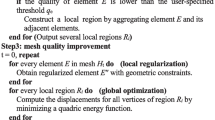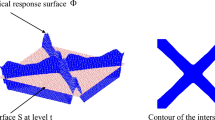Abstract
In this article, we analyze how to measure quality on meshes composed of different types of 3D linear element. In particular, we focus on meshes composed of tetrahedra, pyramids, prisms and hexahedra. We propose a metric based on the scaled Jacobian that can be applied to all four element types and it is normalized in the range [− 1,1]. We validated empirically its effectiveness to properly detect invalid and bad-quality elements using several test cases where our metric is contrasted with already existing ones. We also coded a simple mesh repair algorithm where the reallocation of the nodes was driven from different quality metrics. The results allow to compare the robustness of each metric and its effectiveness on improving overall mesh quality. Finally, it is known that Jacobian-based metrics fail to detect stretched and flat prisms and hexahedra, so we also propose a normalization of the aspect–ratio in those cases.


















Similar content being viewed by others
References
Bucki, M., Lobos, C., Payan, Y., Hitschfeld, N.: Jacobian-based repair method for finite element meshes after registration. Eng. Comput. 27 (3), 285–297 (2011). https://doi.org/10.1007/s00366-010-0198-2
Contreras, D., Hitschfeld-Kahler, N.: Generation of polyhedral delaunay meshes. Procedia Engineering 82, 291–300 (2014). https://doi.org/10.1016/j.proeng.2014.10.391. http://www.sciencedirect.com/science/article/pii/S1877705814016701. 23rd International Meshing Roundtable (IMR23)
Dudley, C.R., Owen, S.J.: Degenerate hex elements. Procedia Engineering 82(0), 301–312 (2014). 23rd International Meshing Roundtable (IMR23)
Fabritius, B., Tabor, G.: Improving the quality of finite volume meshes through genetic optimisation. Eng. Comput. 32(3), 425–440 (2016). https://doi.org/10.1007/s00366-015-0423-0
Freitag, L.: On combining laplacian and optimization-based mesh smoothing techniques. Trends in Unstructured Mesh Generation 220, 37–44 (1997)
Frey, P.J., Borouchaki, H.: Geometric surface mesh optimization. Computing and visualization in Science, pp. 113–121 (1998)
Gargallo-Peiró, A., Roca, X., Peraire, J., Sarrate, J.: Distortion and quality measures for validating and generating high-order tetrahedral meshes. Eng. Comput. 31(3), 423–437 (2015)
Garimella, R.V., Kim, J., Berndt, M.: Polyhedral mesh generation and optimization for non-manifold domains. In: Proceedings of International Meshing Roundtable, pp. 313–330 (2013)
George, P., Borouchaki, H., Barral, N.: Geometric validity (positive Jacobian) of high-order lagrange finite elements, theory and practical guidance. Eng. Comput. 32, 405–424 (2016)
Huo, S., Liu, G., Zhang, J., Song, C.: A smoothed finite element method for Octree-based polyhedral meshes with large number of hanging nodes and irregular elements. Comput. Methods Appl. Mech. Eng. 359, 112646 (2020). https://doi.org/10.1016/j.cma.2019.112646
Ito, Y., Shih, A., Soni, B.: Octree-based reasonable-quality hexahedral mesh generation using a new set of refinement templates. Int. J. Numer. Methods Eng. 77(13), 1809–1833 (2009)
Knupp, P.: Achieving finite element mesh quality via optimization of the Jacobian matrix norm and associated quantities. part ii – a framework for volume mesh optimization and the condition number of the Jacobian matrix. Int. J. Numer. Methods Eng. 48, 1165–1185 (2000)
Knupp, P.M.: Algebraic mesh quality metrics for unstructured initial meshes. Finite Elements in Analysis and Design 39(3), 217–241 (2003). https://doi.org/10.1016/S0168-874X(02)00070-7. http://www.sciencedirect.com/science/article/pii/S0168874X02000707
Knupp, P.M.: A method for hexahedral mesh shape optimization. Int. J. Numer. Methods Eng. 58(2), 319–332 (2003)
Kwok, W., Chen, Z.: A simple and effective mesh quality metric for hexahedral and wedge elements. In: Inproceedings of 9th International Meshing Roundtable, pp. 325–333 (2000)
Lobos, C.: Towards a unified measurement of quality for mixed–elements. Tech. Rep. 2015/01, Departamento de Informática, UTFSM. http://www.inf.utfsm.cl/clobos/tech.html (2015)
Lobos, C., González, E.: Mixed-element octree: a meshing technique toward fast and real-time simulations in biomedical applications. Int. J. Numer. Methods Biomed. Eng. 31(12), 1–31 (2015)
Owen, S., Canann, S., Saigal, S.: Pyramid elements for maintaining tetrahedra to hexahedra conformability. Trends In Unstructured Mesh Generation 220 (1997)
Owen, S.J., Staten, M.L., Sorensen, M.C.: Parallel hexahedral meshing from volume fractions. Eng. Comput. 30(3), 301–313 (2014). https://doi.org/10.1007/s00366-012-0292-8
Parthasarathy, V., Graichen, C., Hathaway, A.: A comparison of tetrahedron quality measures. Finite Elem. Anal. Des. 15, 255–261 (1993)
Pellerin, J., Johnen, A., Remacle, J.F.: Identifying combinations of tetrahedra into hexahedra: a vertex based strategy. Procedia Engineering 203, 2–13 (2017). https://doi.org/10.1016/j.proeng.2017.09.779. http://www.sciencedirect.com/science/article/pii/S1877705817343370. 26th International Meshing Roundtable, IMR26, 18-21 September 2017, Barcelona, Spain
Qian, J., Zhang, Y.: Sharp feature preservation in octree-based hexahedral mesh generation for cad assembly models. In: Proceedings of the 19th International Meshing Roundtable, IMR 2010, pp. 243–262 (2010)
Ruiz-Gironés, E., Roca, X., Sarrate, J.: The receding front method applied to hexahedral mesh generation of exterior domains. Eng. Comput. 28 (4), 391–408 (2012). https://doi.org/10.1007/s00366-011-0233-y
Schroeder, W.J., Shephard, M.S.: A combined octree/Delaunay method for fully automatic 3-D mesh generation. Int. J. Numer. Methods Eng. 29, 37–55 (1990)
Shepherd, J., Johnson, C.: Hexahedral mesh generation for biomedical models in scirun. Eng. Comput 25, 97–114 (2009)
Shewchuk, J.: Delaunay refinement algorithms for triangular mesh generation. Computational Geometry: Theory and Applications 22(1-3), 21–74 (2002)
Shewchuk, J.R.: Constrained Delaunay tetrahedralizations and provably good boundary recovery. In: Proceedings of the 11th International Meshing Roundtable, pp. 193–204. Ithaca (2002)
Stimpson, C., Ernst, C., Pébay, P., Knupp, P., Thompson, D.: The verdict geometric quality library. Tech. Rep. SAND2007–1751 Sandia National Laboratories (2007)
Yamakawa, S., Gentilini, I., Shimada, K.: Subdivision templates for converting a non-conformal hex-dominant mesh to a conformal hex-dominant mesh without pyramid elements. Engineering with Computers 27(1), 51–65 (2011)
Yamakawa, S., Shimada, K.: Hex-dominant mesh generation with directionality control via packing rectangular solid cells. In: Geometric Modeling and Processing. Theory and Applications. GMP 2002. Proceedings. https://doi.org/10.1109/GMAP.2002.1027501, pp 107–118 (2002)
Zhang, Y., Hughes, T., Bajaj, C.: An automatic 3d mesh generation method for domains with multiple materials. Comput. Methods Appl. Mech. Eng. 199(5–8), 405–415 (2010)
Funding
This work has been partially supported by the Franco–Chilean ECOS–Sud Conicyt C16E05 project and by Chilean Fondecyt–1181506 and 1211484 projects.
Author information
Authors and Affiliations
Corresponding author
Additional information
Publisher’s note
Springer Nature remains neutral with regard to jurisdictional claims in published maps and institutional affiliations.
Rights and permissions
About this article
Cite this article
Lobos, C., Arenas, C., Daines, E. et al. Measuring geometrical quality of different 3D linear element types. Numer Algor 90, 423–446 (2022). https://doi.org/10.1007/s11075-021-01193-8
Received:
Accepted:
Published:
Issue Date:
DOI: https://doi.org/10.1007/s11075-021-01193-8




